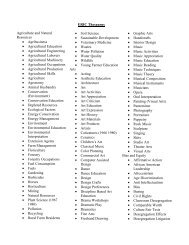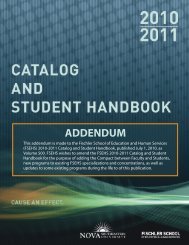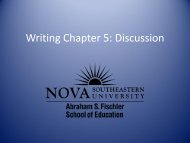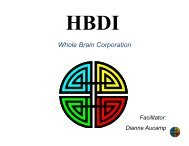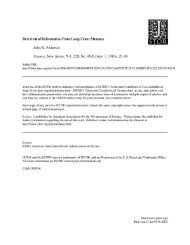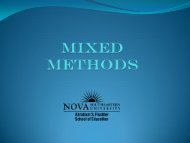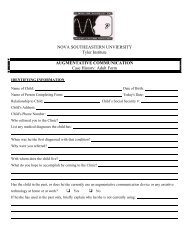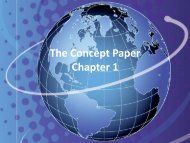Misinformation and Memory: The Creation of New Memories - 1
Misinformation and Memory: The Creation of New Memories - 1
Misinformation and Memory: The Creation of New Memories - 1
You also want an ePaper? Increase the reach of your titles
YUMPU automatically turns print PDFs into web optimized ePapers that Google loves.
Journal <strong>of</strong> Experimental Psychology: General1989, VoL 118, No.1, 100-104Copyright 1989 by the American Psychological Association. Inc,0096-3445/89/$00,75<strong>Misinformation</strong> <strong>and</strong> <strong>Memory</strong>:<strong>The</strong> <strong>Creation</strong> <strong>of</strong><strong>New</strong> <strong>Memories</strong>Elizabeth F. L<strong>of</strong>tus <strong>and</strong> Hunter G. H<strong>of</strong>fmanUniversity <strong>of</strong> WashingtonMisleading information presented after an event can lead people to erroneous reports <strong>of</strong> thatmisinformation. Different process histories can be responsible for the same erroneous report indifferent people. We argue that the relative proportion <strong>of</strong>times that the different process historiesare responsible for erroneous reporting will depend on the conditions <strong>of</strong> acquisition, retention,<strong>and</strong> retrieval <strong>of</strong> information. Given the conditions typical <strong>of</strong> most misinformation experiments,it appears that misinformation acceptance plays a major role, memory impairment plays somerole, <strong>and</strong> pure guessing plays little or no role. Moreover, we argue that misinformation acceptancehas not received the appreciation that it deserves as a phenomenon worthy <strong>of</strong> our sustainedinvestigation. It may not tell us anything about impairment <strong>of</strong> memories, but it does tell ussomething about the creation <strong>of</strong> new memories.Once upon a time, a man (whom we'll call Mike) stumbledupon an armed robbery in a hardware store. <strong>The</strong> robberrummaged around the cluttered store br<strong>and</strong>ishing a silverweapon; finally, he stole all the money. <strong>The</strong>n, almost as anafterthought, he grabbed a h<strong>and</strong> calculator <strong>and</strong> a hammer,placing these in his satchel as he left the store. <strong>The</strong> police weresummoned immediately, but before they arrived, Mike talkedto another customer about the robbery. We'll call her Maria.Maria told Mike that she saw the robber grab a calculator <strong>and</strong>a screwdriver, stuffing them in his satchel as he left the store.<strong>The</strong> police arrived, <strong>and</strong> when they questioned Mike, he recountedthe robbery at some length: He described in detailthe silver weapon, the money, <strong>and</strong> the calculator. When thepolice asked him about a tool that they heard had been taken,"Did you see if it was a hammer or a screwdriver?", he said,"Screwdriver."How did it happen that an ordinary upst<strong>and</strong>ing guy likeMike came to remember seeing a screwdriver? (a) He mightnever have seen the hammer in the first place, <strong>and</strong> he mentionedthe screwdriver because he remembered hearing aboutit. (b) He could have remembered both the hammer <strong>and</strong> thescrewdriver, but he mentioned the screwdriver when askedbecause he trusted Maria's memory more than he trusted hisown. (c) He could have failed to see the hammer <strong>and</strong> failedto hear Maria mention the screwdriver, <strong>and</strong> he simply guessedabout the tool when asked by the police. Last, (d) he couldhave initially had a memory for a hammer, but when Mariamentioned the screwdriver, his memory was altered, suppressed,or impaired in some way. In fact, if there had beenfour customers in Mike's shoes that day, they might have allreported seeing a screwdriver, each for a different reason. Put<strong>The</strong> underlying research fundamental to the arguments made herewas supported by a grant from the National Institute <strong>of</strong> MentalHealth.We thank G. L<strong>of</strong>tus for his helpful comments.Correspondence concerning this article should be addressed toElizabeth F. L<strong>of</strong>tus, Department <strong>of</strong>Psychology, University <strong>of</strong> Washington,Seattle, Washington 98195.another way, entirely different process histories can lead tothe same final response.Mike's erroneous report is analogous to the thous<strong>and</strong>s <strong>of</strong>erroneous reports after the receipt <strong>of</strong> misinformation thathave been obtained in laboratory studies <strong>of</strong> the "misinformationeffect" conducted in the United States, Canada, GreatBritain, Germany, Australia, <strong>and</strong> the Netherl<strong>and</strong>s (Ceci, Ross,& Toglia, 1987a, 1987b; Ceci, Toglia, & Ross, 1988; Ch<strong>and</strong>ler,1989; Geiselman, 1988; Gibling & Davies, 1988; Gudjonsson,1986; Hammersley & Read, 1986, in press; Kohnken &Brockmann, 1987; Kroll & Ogawa, 1988; Kroll & Timourian,1986; Lehnert, Robertson, & Black, 1984; Morton, Hammersley,& Bekerian, 1985; Pirolli & Mitterer, 1984; Register &Kihlstrom, 1988; Sheehan, 1988; Sheehan & Tilden, 1986;Smith & Ellsworth, 1987; Wagenaar & Boer, 1987; Zaragoza& Koshmider, 1989; Zaragoza, McCloskey, & Jamis, 1987).This enthusiasm for investigating the misinformation effecthas been fueled by an abiding interest on the part <strong>of</strong>researchersin uncovering the mechanism that produces it.When the first collection <strong>of</strong> misinformation experimentsappeared in the mid-1970s, the lesson that was being learnedfrom these experiments was that misleading postevent informationcan impair memory <strong>of</strong>an original event (L<strong>of</strong>tus, 1975,1977, 1979). According to the "impairment" view, Mike'srecollection <strong>of</strong>a screwdriver came about because <strong>of</strong>the fourthmechanism just cited: that his memory for the hammer hadbeen altered by the misleading postevent information. <strong>The</strong>notion <strong>of</strong> memory alteration bothered people. It challengedthe prevailing textbook view that memories, once stored, arepermanently stored; that traces once formed always survive;<strong>and</strong> that forgetting is due to a labile retrieval system (Atkinson& Shiffrin, 1968; Chechile, 1987). In fact, at least one theoryexplicitly claimed that postevent information does not impairunderlying memory traces; rather, it impairs only accessibilityto those original memories (Morton et aI., 1985).Among the more articulate <strong>of</strong>those who were bothered byall notions <strong>of</strong> impairment were McCloskey <strong>and</strong> Zaragoza(1985). <strong>The</strong>y claimed that memory for an original event isnot impaired by misleading postevent information. According100
COMMENTS 101to the "no-impairment view," Mike's recollection <strong>of</strong>a screwdrivercame about because <strong>of</strong> one <strong>of</strong> the first three mechanismscited earlier: that he never saw the hammer but rememberedhearing about the screwdriver, that he rememberedboth the hammer <strong>and</strong> the screwdriver but trusted the screwdriverinformation more, or that he remembered neither toolbut guessed that it was a screwdriver. McCloskey <strong>and</strong> Zaragozadevised a test that excluded the misinformation as apossible response alternative, <strong>and</strong> they found no misinformationeffect. <strong>The</strong>ir procedure was analogous to the policeman'sasking Mike whether the tool he had seen the robbersteal was "a hammer or a wrench." On the basis <strong>of</strong> theobservation <strong>of</strong> reasonably good reporting <strong>of</strong> the hammer,given this "modified" test, McCloskey <strong>and</strong> Zaragoza arguedthat it was not necessary to assume any memory impairmentat all-neitherimpairment <strong>of</strong>traces nor impairment <strong>of</strong>access.McCloskey <strong>and</strong> Zaragoza (1985) were right about one thing:When the policeman asked Mike whether he saw a hammeror screwdriver, his answer, "Screwdriver," did not necessarilyimply that he once had a memory for a hammer <strong>and</strong> thatmemory was now impaired. So the question now is, Doesmisinformation ever produce memory impairment? Belli(1989) says "Maybe," whereas Tversky <strong>and</strong> Tuchin (1989)say "Yes," on the basis <strong>of</strong>new findings involving "Yes"rNo"retrieval tests, rather than the usual forced-choice recognitiontests. Although the studies are similar in that both involved"Yes"rNo" tests, they differed in terms <strong>of</strong> the number <strong>of</strong>tests concerning a critical category <strong>of</strong> item (e.g., the number<strong>of</strong> tests about various tools) that any individual subject receives.More specifically, Belli's procedure is analogous to thepoliceman's asking Mike either "Did you see a hammer-yesor no?'; or "Did you see a wrench-yes or no?" (Le., nosubject received both questions). Tversky <strong>and</strong> Tuchin's procedureis analogous to the policeman's asking Mike bothquestions <strong>and</strong>, in addition, a similar question about a screwdriver.In both studies, the researchers found that misleadingpostevent information reduced the "Yes" responses to thequestion about the original item (e.g., the hammer). In bothstudies, they found that subjects were quite good at rejectingthe novel item (e.g., the wrench). Belli (1989) found thatmisled subjects were better than control subjects at rejectingthe novel item, whereas Tversky <strong>and</strong> Tuchin (1989) foundthat they were as good as control subjects. Belli never askedpeople what they thought about the misinformation item(e.g., the screwdriver), but Tversky <strong>and</strong> Tuchin did. Misledsubjects were more likely to incorrectly say that they had seenthe misinformation item than to say that they had seen theone they actually saw. When they adopted the misinformationitem as their own memory, they did so with a high degree <strong>of</strong>confidence, which is not something that one would expectfrom people who are merely guessing.<strong>The</strong> collection <strong>of</strong> experiments seem to be teaching us animportant lesson: When people do not have an original memory,they can <strong>and</strong> do accept misinformation <strong>and</strong> adopt it astheir own memory. However, it also appears that misinformationcan sometimes impair an otherwise accessible originalmemory. But this conclusion leaves us with many unansweredquestions. How much impairment occurs? What does it meanto say that memory has been impaired? Is it the memorytraces themselves that are impaired, or is it our ability toreach those memories?How Much Impairment Occurs?Belli (1989, Experiment 2) estimated that 32.6% <strong>of</strong>correctresponses about the event item resulted from an actual memoryfor the item in the control condition. He estimated that26% <strong>of</strong>the correct responses resulted from an actual memoryfor the item in the misled condition, which was thus a drop<strong>of</strong> 6.6%. Although the 6.6% difference between control <strong>and</strong>misled subjects' performances appeared on the surface to berather small, Belli stressed that the impact <strong>of</strong>misinformationon actual memory was actually more substantial. When consideringonly the responses traceable to a true memory for theoriginal item, the misled subjects suffered more than a 20%(6.6% <strong>of</strong> 32.6%) reduction in accuracy in comparison withcontrol subjects. When looked at in this way, this reductionsuggests that memory impairment can be a significant source<strong>of</strong>erroneous reporting. However, this may not always be thecase. In the experiment in which Belli obtained a 20% impairment,the exposure time was 5 s, the interval until misinformationwas 5 min, <strong>and</strong> the final test occurred 10 minafter that. <strong>The</strong> relative proportion <strong>of</strong>times that the differentprocess histories cited earlier are responsible for erroneousreporting will depend completely on the conditions <strong>of</strong>acquisition,retention, <strong>and</strong> retrieval <strong>of</strong> information. Consider anextreme case: Mike sees a hammer; minutes later Mariamentions a screwdriver, <strong>and</strong> months pass before the policemanasks Mike, "Did you see a hammer or a screwdriver?"<strong>The</strong> response <strong>of</strong> "Screwdriver" would very likely be due topure guessing. On the other h<strong>and</strong>, if Mike saw the hammer,<strong>and</strong> months passed before Maria talked to him about ascrewdriver <strong>and</strong> the policeman questioned him, his response<strong>of</strong> "Screwdriver" would very likely be due to what Belli callsmisinformation acceptance.What Does It Mean to Say That<strong>Memory</strong> Has Been Impaired?<strong>Memory</strong> impairment could refer to a weakening <strong>of</strong>memorytraces, or a clouding <strong>of</strong> memory, or an intrinsic impoverishment<strong>of</strong> memory. It could refer to what an earlier generation<strong>of</strong> psychologists called "unlearning" (Barnes & Underwood,1959; Melton & Irwin, 1940) or to what a later generationcalled "disintegration" <strong>of</strong>features (Brainerd & Reyna, 1988b).Whatever the mechanism, its fading involves things that wecurrently cannot see or touch but can only infer from behavior.Another potential form <strong>of</strong> interference has been calledsource misattribution (Lindsay & Johnson, 1987). <strong>The</strong> ideahere is that there is access to the postevent item but confusionregarding its origin. Although appealing at first glimpse, thenotion <strong>of</strong> source misattribution has been tossed around; notmuch thought has been given to what it really is in the context<strong>of</strong>exposure to misinformation.Belli (1989) argues that memory impairment <strong>and</strong> sourcemisattribution hypotheses have one thing in common: the
102 COMMENTSnotion that misleading information interferes with the abilityto re~emberan original item. He combines these hypotheses,refemng to them collectively as misinformation interferencehypotheses, <strong>and</strong> then distinguishes them from misinformationacceptance hypotheses (in which no interference is assumed).He eventually concludes that some misinformation interferenceoccurs <strong>and</strong> then declines to commit to deciding whetherimpairment or source misattribution or both are the responsibleparties.This line <strong>of</strong>argument raises the important question <strong>of</strong>justwhat source misattribution is. We think that neither Belli(1989) nor Tversky <strong>and</strong> Tuchin (1989) adequately dealt withthis issue. Source misattribution means, in its most generalsense, confusion over the source <strong>of</strong> origin <strong>of</strong> some item. Itmight involve interference with an original item in memory,but on the other h<strong>and</strong> it might not. Suppose that Mike neversaw the hammer in the first place. He subsequently hearsMaria talk about a screwdriver <strong>and</strong> decides that he has seenthe screwdriver during the original robbery. Mike has committeda source attribution error, but no interference with anoriginal memory has occurred because there was no originalmemory to begin with. Change the facts slightly <strong>and</strong>, 10 <strong>and</strong>behold, we have on our h<strong>and</strong>s a source attribution error thatis indeed associated with interference with an original item inmemory. If Mike encoded the hammer <strong>and</strong> subsequentlyencoded "screwdriver" from Maria, he could become confusedabout the source <strong>of</strong>"screwdriver," could reconstruct hismemory to include a screwdriver, <strong>and</strong> simultaneously could"impair" his original memory for a hammer. In this case,Mike would have committed a source attribution error thatwas associated with memory impairment. This analysis makesit clear that there is more than one type <strong>of</strong> source misattribution.<strong>The</strong> type that does not involve memory impairmentis definitely at least partly responsible for the observed results(at least in some subjects); this is in fact what misinformationacceptance is all about.However, Belli (1989), at least, showed more than this. Heshowed that memory impairment has occurred. It could resultfrom a "clouding" or degrading <strong>of</strong> memory (picture a Xerox<strong>of</strong> a Xerox <strong>of</strong> a Xerox), or it could be a type <strong>of</strong> sourcemisattribution that is associated with accessibility <strong>of</strong>the originalmemory, or it could be some <strong>of</strong>both. Whatever he wantsto call it, it appears to involve a type <strong>of</strong>impairment, <strong>and</strong> thusBelli's conclusions favoring the memory impairment hypothesiscould be expressed more strongly than in fact they were.On this fine point, Belli could take a lesson from Tversky <strong>and</strong>Tuchin (1989) on how not to be a shrinking violet. <strong>The</strong>yunhesitatingly characterize their data as arguing "against theclaim that nothing happens to the memory for the originalevent as a consequence <strong>of</strong> misleading information" (p. 89).In reaching this conclusion, we acknowledge that a differenttype <strong>of</strong> research is probably necessary before specific claimsabout what "impairment" means can really be addressed.Some biologically oriented psychologists have suggested thatadditional neurobiological facts are required before researcherscan settle the issue <strong>of</strong> whether impaired performancereflects an actual loss <strong>of</strong> information from storage <strong>and</strong> aco~~sponding regression <strong>of</strong>some <strong>of</strong>the synaptic changes thatongmally represented that stored information (Squire, 1987).Tversky <strong>and</strong> Tuchin (1989), in a related vein, asserted thatspecific claims about the retroactive alteration <strong>of</strong> memorytraces cannot be addressed, given current knowledge <strong>and</strong>~ools. We bel~eve that the future "knowledge <strong>and</strong> tools" maymvolve the discovery <strong>of</strong>new neurobiological facts, but strongadvances in theorizing in this area will occur with new developmentsin cognitive research.How Much Guessing Occurs?Among the reasons why Mike might have reported seeinga screwdriver, one (cited earlier) is that he failed to encodethe hammer <strong>and</strong> he did not hear Maria mention the screwdriver,but when asked whether it was a hammer or a screwdriverthat he saw, he simply guessed that it was a screwdriver.In other words, he made a pure guess, as opposed to a biasedguess. We argued earlier that pure guessing could undercertain conditions <strong>of</strong> acquisition, retention, <strong>and</strong> retrieval, beresponsible for a significant proportion <strong>of</strong> erroneous "screwdriver"reports. However, in the current studies, we believethat pure guessing plays little or no role. Tversky <strong>and</strong> Tuchin(1989) found that when misled, subjects were certain <strong>of</strong>theirerrors, which is not the type <strong>of</strong>response that one would expectfrom people who were merely guessing.Using the now-familiar burglary sequence (McCloskey &Zaragoza, 1985), Donders, Schooler, <strong>and</strong> L<strong>of</strong>tus (1987) alsogathered data that argue against the notion that the "pureguessing" process history makes much <strong>of</strong> a contribution tothe misinformation effect. In this study, subjects watched theburglary sequence (including, for example, a hammer), thenreceived misinformation (e.g., about a screwdriver) or neutralinformation about four critical items, <strong>and</strong> then were tested in:h?t Tversky <strong>and</strong> Tuchin (1989) call the "L<strong>of</strong>tus test" (e.g.,Old you see a hammer or a screwdriver?"). <strong>The</strong> innovationin Donders et at's (1987) research is that speel!<strong>of</strong>respondingwas measured, in addition to confidence. Ifa high proportion<strong>of</strong> the misled subjects who selected the misinformation (thescrewdriver) were simply guessing, one would expect theirresponse times to be long <strong>and</strong> not associated with a highdegree <strong>of</strong> confidence. <strong>The</strong> obtained confidence data revealedthat when misled subjects selected the misinformation itemthey did so with a high degree <strong>of</strong> confidence (just as Tversk;& Tuchin, 1989, found when they used the "Yes"rNo" test).<strong>The</strong> fastest response times <strong>of</strong>all occurred when misled subjectsselected the misinformation item (see Figure 1).In sum, because subjects embrace the misinformation itemwith a ,high degree <strong>of</strong>confidellce, <strong>and</strong> they do so very quickly,we believe that pure guessing does not play a significant rolein producing the misinformation effect in studies in whichfairly typical exposure time <strong>and</strong> retention interval parametersare used. We do not mean to imply that pure guessing neveroccurs, but only that is a rare process history in the misledcondition.<strong>Misinformation</strong> Acceptance: A Wcnrthy PhenomenonAmong the many reasons why Mike might have reportedseeing a screwdriver after hearing Maria mention it, one (cited
COMMENTS 103uQ)en.sIa:30002500200015001000 -'----'---MisledConditionControlCorrectIncorrectFigure 1. Reaction times (RT) associated with correct <strong>and</strong> inco~e~tresponses (Donders, Schooler, & L<strong>of</strong>tus, 1987). (Msec = mJihseconds.)earlier) is that he never saw the hammer in the fIrst place, <strong>and</strong>he claimed that he saw the screwdriver because he rememberedhearing about it. IfMike reported the screwdriver withconviction, we would say, in Belli's (1989) language, that hehad accepted the misinfonnation. In fact, this is one <strong>of</strong> theclearest cases <strong>of</strong> misinfonnation acceptance; it cannot bydefInition involve any original memory impainnent becausethere was no original memory to be impaired. Much <strong>of</strong> thetheoretical discussion about the misinfonnation effect wouldleave us with the impression that this process is uninteresting.It may not, <strong>of</strong> course, tell us anything about impainnent <strong>of</strong>memories, but it does tell us something about the creation <strong>of</strong>new memories. If a memory for a screwdriver came aboutthrough the process.<strong>of</strong> suggestion but was subjectively as real<strong>and</strong> as vivid as a memory that arose from the actual perception<strong>of</strong>a screwdriver, we would fInd this fact important from botha theoretical <strong>and</strong> an applied perspective. In fact, there isevidence that suggested memories might differ statisticallyfrom genuine memories (Schooler, Gerhard, & L<strong>of</strong>tus, 1986),but they still have great similarities in common. For onething, suggested memories are expressed with a great deal <strong>of</strong>confIdence, just as are some genuine memories (Donders etaI., 1987; Tversky & Tuchin, 1989). Moreover, suggestedmemories are quickly accessible, just as are some genuinememories (Donders et al., 1987).Thus researchers in this area should be more interested in"misinfonnation acceptance," especially when it is associatedwith a high degree <strong>of</strong>conviction about the new memories. Inexploring the factors that enhance susceptibility to misinformation,we have discoveredl that allowing time to pass afterthe event, so that the original memory can fade, makes aperson particularly vulnerable to suggestion (L<strong>of</strong>tus, Miller,& Bums, 1978). Some items that could never be modifIedwhen they are fresh in the mind will eventually fade to thepoint that modifIcation is possible. <strong>The</strong> process could essentiallyinvolve one <strong>of</strong>creating a new memory, but it would stillbe an interesting one, worthy <strong>of</strong>our research attention.<strong>The</strong>se ideas also bear on Belli's (1989) observation thathaving a better overall memory for original items would makeit easier for misinfonnation interference to be detected (othershave similarly argued for the crucial role played by thestrength <strong>of</strong> the original memory: Brainerd & Reyna, 1988a;Ceci et al., 1987a; Ch<strong>and</strong>ler, 1989). Belli did indeed fInd moremisinfonnation interference when there was more memoryto begin with. However, there is a limit. In the extreme case,when memory for an original item is virtually perfect, peopleare unaffected by misinfonnation (e.g., see L<strong>of</strong>tus, 1979).<strong>The</strong>y readily notice a discrepancy between what they have inmemory <strong>and</strong> what is being <strong>of</strong>fered to them as misinfonnation(Tousignant, Hall, & L<strong>of</strong>tus, 1986). In order to affect thosepersons whose memory for some critical item is strong tobegin with, one must wait until the memory fades to a levelbelow which they are not likely to immediately notice discrepancies.ConclusionWe are grateful to McCloskey <strong>and</strong> Zaragoza (1985) formaking it evident that there are different ways <strong>of</strong> arriving atthe same memory report. Initially, we thought that memoryimpairment was implicated in the process <strong>of</strong> distortions inreporting that are due to misleading postevent infonnation.We are gratilled to fInd some support for this notion in thecurrent studies. However, even in the absence <strong>of</strong> memoryimpainnent, the fInding that people can come to acceptmisinfonnation <strong>and</strong> adopt it faithfully as their own is animportant phenomenon in its own right. Put another way,regardless <strong>of</strong> whether there is a buried original memory,waiting to be kissed awake like Sleeping Beauty, researchersstill must take seriously the erroneous memory reports thatare so freely obtained. Researchers have created them inlaboratory environments, which Tversky <strong>and</strong> Tuchin (1989)claim are "unusual." However, we believe that we have tappeda phenomenon that occurs quite <strong>of</strong>ten in real life wheneverpeople who experience the same event talk to one another,overhear each other talk, or gain access to new infonnationfrom the media, interrogators, or other sources. We believethat the misinfonnation effect is sufficiently pervasive <strong>and</strong>eventually may be so highly controllable that we are temptedto propose a Watsonian future for the misinfonnation effect(see Watson, 1939, p. 104): Give us a dozen healthy memories,well-fonned, <strong>and</strong> our own specifIed world to h<strong>and</strong>le them in.And we'll guarantee to take anyone at r<strong>and</strong>om <strong>and</strong> train itto become any type <strong>of</strong> memory that we might select-hammer,screwdriver, wrench, stop sign, yield sign, Indian chiefregardless<strong>of</strong> its origin or the brain that-holds it.ReferencesA~, R. c., & Shiffrin, R. M. (1968). Human memory: Aproposed system <strong>and</strong> its control processes. In K. W. Spence &J. T. Spence (Eds.), <strong>The</strong> psychology <strong>of</strong> learning <strong>and</strong> motivation(Vol. 2, pp. 89-195). <strong>New</strong> York: Academic Press.Barnes, J. M., & Underwood, B. M. (1959). "Fate" <strong>of</strong> first-listassociations in transfer theory. Journal <strong>of</strong>ExperimentalPsychology,58.97-105.Belli, R. F. (1989). Influences <strong>of</strong> misleading postevent information:<strong>Misinformation</strong> interference <strong>and</strong> acceptance. Journal <strong>of</strong> ExperimentalPsychology: General, 118. 72-85.





